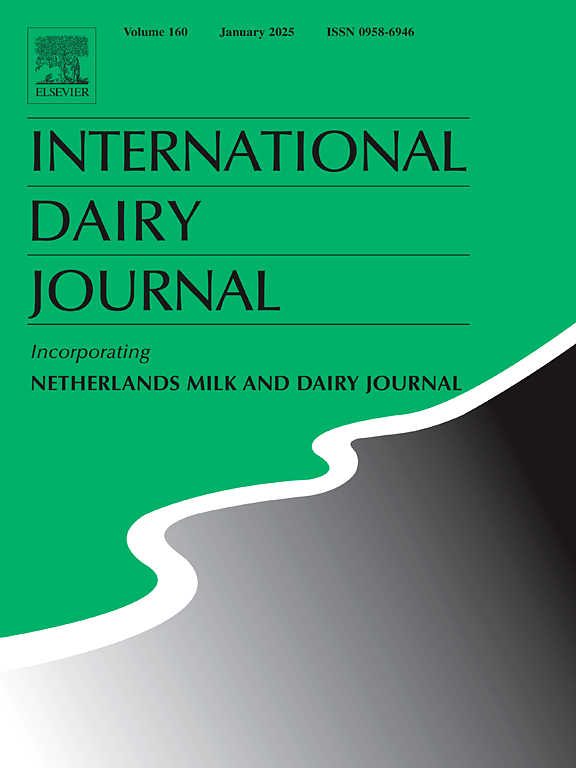Effects of ultrasonic treatment on protein in goat milk: Changes in structure and function and enhancement of heat-sterilized protein function
IF 3.1
3区 农林科学
Q2 FOOD SCIENCE & TECHNOLOGY
引用次数: 0
Abstract
Native whey protein and casein micelles in goat milk often struggle to exhibit desirable functional properties, such as poor heat stability of whey protein and low solubility of casein. To address these limitations, this study applied ultrasound treatment to goat milk and heat-sterilized goat milk to improve protein functionalities, including solubility, foaming, emulsification, and digestibility. The results showed that the optimal treatments to improve the functional properties of goat milk protein were 400W, 7 min. Under these conditions, whey protein and casein surface hydrophobicity increased to 167,578.90 and 444,658.87 ± 2745.48 (P < 0.05). Meanwhile, the results of circular dichroism, fluorescence spectrum and SDS-PAGE revealed that ultrasound treatment weakened the hydrogen bonding and hydrophobic interaction within the components of protein, resulting in protein structure unfolding and increased flexibility. These changes increased the solubility of casein and optimized the foaming, digestibility and emulsification properties of goat milk protein. Additionally, ultrasonic treatment effectively disperses heat-aggregated goat milk proteins, reducing the particle sizes of whey protein from 3370 nm to 1434.67 nm and casein from 796.5 nm to 355.95 nm. This treatment not only enhances the functional properties of the proteins but also extends the storage stability of pasteurized goat milk to 12 days.

超声处理对羊奶中蛋白质的影响:结构和功能的变化及热杀菌蛋白功能的增强
羊奶中的天然乳清蛋白和酪蛋白胶束往往难以表现出理想的功能特性,如乳清蛋白的热稳定性差,酪蛋白的溶解度低。为了解决这些局限性,本研究对羊奶和热灭菌羊奶进行了超声处理,以改善蛋白质的功能,包括溶解度、起泡、乳化和消化率。结果表明,提高羊奶蛋白功能特性的最佳处理为400W, 7 min。在此条件下,乳清蛋白和酪蛋白的表面疏水性分别提高到167,578.90和444,658.87±2745.48 (P <;0.05)。同时,圆二色性、荧光光谱和SDS-PAGE结果显示,超声处理削弱了蛋白质组分内部的氢键和疏水相互作用,导致蛋白质结构展开,柔韧性增加。这些变化提高了酪蛋白的溶解度,优化了羊奶蛋白的发泡、消化和乳化性能。此外,超声波处理有效地分散了热聚集的羊奶蛋白,将乳清蛋白的粒径从3370 nm减小到1434.67 nm,酪蛋白的粒径从796.5 nm减小到355.95 nm。该处理不仅提高了蛋白质的功能特性,而且延长了巴氏羊奶的储存稳定性至12天。
本文章由计算机程序翻译,如有差异,请以英文原文为准。
求助全文
约1分钟内获得全文
求助全文
来源期刊

International Dairy Journal
工程技术-食品科技
CiteScore
6.50
自引率
9.70%
发文量
200
审稿时长
49 days
期刊介绍:
The International Dairy Journal publishes significant advancements in dairy science and technology in the form of research articles and critical reviews that are of relevance to the broader international dairy community. Within this scope, research on the science and technology of milk and dairy products and the nutritional and health aspects of dairy foods are included; the journal pays particular attention to applied research and its interface with the dairy industry.
The journal''s coverage includes the following, where directly applicable to dairy science and technology:
• Chemistry and physico-chemical properties of milk constituents
• Microbiology, food safety, enzymology, biotechnology
• Processing and engineering
• Emulsion science, food structure, and texture
• Raw material quality and effect on relevant products
• Flavour and off-flavour development
• Technological functionality and applications of dairy ingredients
• Sensory and consumer sciences
• Nutrition and substantiation of human health implications of milk components or dairy products
International Dairy Journal does not publish papers related to milk production, animal health and other aspects of on-farm milk production unless there is a clear relationship to dairy technology, human health or final product quality.
 求助内容:
求助内容: 应助结果提醒方式:
应助结果提醒方式:


